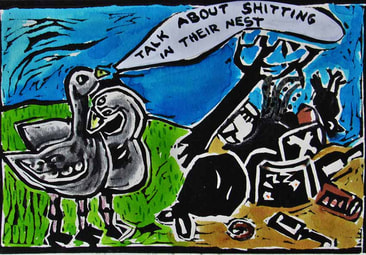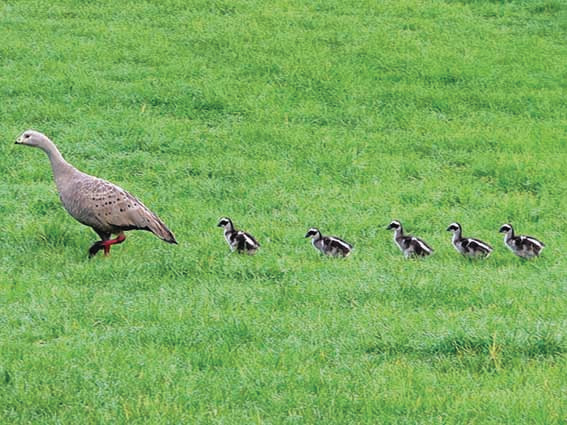 Cartoon: Natasha Williams-Novak
Cartoon: Natasha Williams-Novak BY THE 1950s, according to the Australian Museum, “numbers of the Cape Barren Goose were so low that biologists feared they may be close to extinction". They remain one of the world's rarest geese.
Birdlife Australia still lists the Cape Barren goose as “vulnerable” in Victoria and NSW, and rare in South Australia.
How do we tie that in with a bird now described by some Phillip Islanders as “a pest” and “in plague proportions”? Cr Stephen Fullarton recently told the ABC the geese “could become the cane toads of the south”.
After being hunted almost to the point of extinction, the geese are now protected under the Wildlife Act 1975. Six geese were released on the island in 1984 as part of a national bird recovery program. By 2009 that number had grown to 500 and in the past 10 years to an estimated 3000.
The stately big birds with the unhurried gait have become a feature of the island, a source of great interest for visitors and the bane of graziers because of their liking for fresh pastures and school playing fields.
Talk to locals, particularly farmers, and you hear that numbers of Cape Barren geese have exploded in recent years. Some have blamed the success of a fox eradication program which means the geese now have no natural predators on the island.
Last month a group from Phillip Island asked Bass Coast councillors to support them in looking for a solution.
One of them was Anne Davie, a Ventnor farmer and vice-president of the Phillip Island Conservation Society. The Davies have access to Class B water from Westernport Water and had planned to grow vegetables on their farm but it has proved impossible with more than 100 geese on the farm.
“I speak today with a heavy heart,” she told councillors. “None of us want to be shooting, culling, poisoning but we have a problem. We’re informing people reluctantly and sadly. Please tell us how to manage this.”
“We’ve been noticing the increase in the past two or three years. With climate change and the drought, they’re being challenged too. They’re here because Ventnor is good farmland. They have five to seven eggs every year so it’s increasing exponentially. We’ve been here for 60 years and we’ve never seen so many geese.”
The minutes of Phillip Island Nature Parks community advisory meetings show concerns being expressed about geese numbers as far back as 2013 and 2104.
However, Nature Parks says the latest goose count did not reveal any increase in numbers over the past two years. In response to concerns, however, PINP will count the geese every six months instead of every two years.
It has also begun a project with two Phillip Island landholders and Federation University. to assess the impacts of Cape Barren geese on renovated pasture and forage crops. The first phase of the project will last for 12 months.
Nature Parks CEO Catherine Basterfield said the recent drought conditions meant geese and swamp wallabies were more visible on roadsides and visiting new areas such as farms and gardens in their search for food and water.
“Living with wildlife is what makes Phillip Island special. We also recognise that this can present challenges which must be tackled together as an informed community.”
Meanwhile, the council has written to the State Government seeking assistance and for a stronger role to be played by the Department of Environment, Land Water and Planning (DELWP), which is responsible for administering the Wildlife Act.
A working group has been set up, including landholders and representatives of the council, Nature Parks and the DELWP.
Cr Michael Whelan said geese numbers were overwhelming for landholders but management must be based on strong science and be humane.
“I am very confident in the scientists who are working on this and advising the group that has been formed to consider the best way forward.”
Geese are not the only natural challenge the island is facing at present. At Silverleaves, debate continues over the council’s plan to remove three mature pines from the foreshore.
In a petition to the council, signed by 122 people, local Marion Roberts wrote: “These majestic, mature trees have been part of the foreshore landscape at Silverleaves for decades - living harmoniously within the Coastal Banksia and Tea Tree woodland. The trees are of significant ecological and cultural value, pose no threat of 'invasion' to surrounding tree species, provide important habitat for bird species and have a right to exist.
“In an environment under pressure from climate change right now the removal of ANY healthy tree is misguided and irresponsible.”
By Thursday morning, Ms Roberts had collected a further 124 signatures on a Change.org petition.
The president of the Phillip Island Conservation Society, Jeff Nottle, acknowledged there was some reticence to support the removal of any tree these days, as our trees are under such sustained assault on many fronts - especially due to the bushfire regulations - and the removal of the trees could create destabilisation.
However, he said Pinus radiata was considered an environmental weed in Victoria.
“This means it is a species that invades native ecosystems and has the potential to adversely affect the survival of native flora and fauna or the functioning of ecosystems. The invasion of native vegetation by environmental weeds is listed as a potentially threatening process under the Flora and Fauna Guarantee Act, and Pinus radiata is considered to pose a problem for indigenous vegetation in our local area.
“We are keen that the tree removal is done carefully, given the sensitivity of our foreshore areas, and that the area is quickly replanted with a suitable indigenous species, e.g. Banksia integrifolia, and that the plantings are protected from wallabies”
